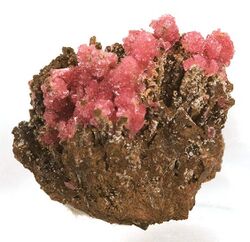Chemistry:Miguelromeroite
| Miguelromeroite | |
|---|---|
 | |
| General | |
| Category | Mineral |
| Formula (repeating unit) | MnS(AsO 4) 2(HAsO 4) 2 · 4H 2O |
| Crystal system | Monoclinic |
| Crystal class | Prismatic H-M symbol: 2/m |
| Space group | B2/b |
| Unit cell | 1,624.38 |
| Identification | |
| Color | Salmon pink to orange |
| Twinning | None observed |
| Cleavage | Good on {100} |
| Fracture | Conchoidal |
| Mohs scale hardness | 4 |
| |re|er}} | Vitreous |
| Streak | Pale pink |
| Diaphaneity | Transparent |
| Density | 3.69 |
| Optical properties | Biaxial (−) |
| Refractive index | nα = 1.713 nβ = 1.723 nγ = 1.729 |
| Birefringence | 0.016 |
| Pleochroism | Visible |
| 2V angle | Measured: 70° Calculated: 75° |
Miguelromeroite is a mineral named for Miguel Romero Sanchez by Anthony Robert Kampf. The mineral, first described in 2008[2] was named in 2009, the same year it got approved by the International Mineralogical Association.
Properties
Miguelromeroite is a member of the hureaulite group, and is the magnesium analogue of the mineral sainfeldite. It is known as a synthetic compound,[3] and was originally labeled as villyaellenite due to the very rare complex arsenate microcrystals.[2] It shows pleochroic attributes, which is an optical phenomenon that makes gems to be seen a different color depending on the axis it is being inspected. Viewing it from the Z axis, the mineral can be seen in a pale pink color. It was redefined as an intermediate species of the series. It is the full magnesium endmember of the series. Crystals are up to 4 cms in length, and are elongated on [001] with forms {100}, {110} and {101̅}.[4]
Structure
The mineral's structure is defined by an octahedral edge-sharing pentamer. The pentamers are linked into a loose framework by sharing corners with octahedra in adjacent pentamers and they are further linked through AsO4 and AsO3OH tetrahedra. There are three distinct octahedral sites: M1, M2, and M3. In miguelromeroite's structure, all of the octahedral sites are occupied by magnesium and the average bond lengths for the sites fall within a relatively narrow range. Though the differences in the sites suggest that the sites M2 and M3 contain small amounts of zinc and calcium.[4]
Mines
The samples were from the Veta Negra mine in Chile. Other mines include Gozaisho mine in Honshu island, Japan, and Mina Ojuela in Mapimi, Durango, Mexico. It's a type locality only in these three mines.[3]
References
- ↑ Warr, L.N. (2021). "IMA–CNMNC approved mineral symbols". Mineralogical Magazine 85 (3): 291–320. doi:10.1180/mgm.2021.43. Bibcode: 2021MinM...85..291W.
- ↑ 2.0 2.1 Minerals, Dakota Matrix. "Miguelromeroite mineral information and data" (in en). https://www.dakotamatrix.com/mineralpedia/9810/miguelromeroite.
- ↑ 3.0 3.1 "Miguelromeroite". https://www.mindat.org/min-39333.html.
- ↑ 4.0 4.1 R. Kampf, Anthony (2009). "Miguelromeroite, the Mn analogue of sainfeldite, and redefinition of villyaellenite as an ordered intermediate in the sainfeldite-miguelromeroite series". American Mineralogist 94 (11–12): 1535–1540. doi:10.2138/am.2009.3278. Bibcode: 2009AmMin..94.1535K. https://rruff-2.geo.arizona.edu/uploads/AM94_1535.pdf.
 |

